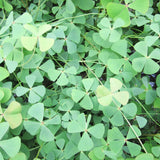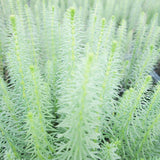Eleocharis Acicularis Aquatic Pond Plant - Hair Grass
Eleocharis acicularis, commonly known as Hairgrass, is a popular aquatic plant that adds a beautiful and natural touch to freshwater aquariums. It is characterized by its thin and grass-like appearance.
Here is a detailed description and care guide for Eleocharis acicularis:
Description:
Eleocharis acicularis is a small, perennial grass-like plant that forms dense carpets in aquariums. It features thin, cylindrical stems that can reach a height of 5-10 centimeters (2-4 inches) under ideal conditions. The leaves are very fine and needle-like, giving the plant a delicate and feathery appearance. The overall coloration is light green, providing a vibrant and fresh look to the aquarium.
Care Guide:
Lighting: Hairgrass can thrive in a wide range of lighting conditions, but moderate to high lighting is recommended to promote compact growth and prevent the plant from stretching. Provide around 2-3 watts per gallon of full-spectrum lighting to ensure proper photosynthesis.
Water Parameters: Hairgrass prefers slightly acidic to neutral water conditions with a pH range of 6.0-7.5. The temperature should be kept between 20-26°C (68-79°F). It can tolerate a wide range of water hardness, but softer water is generally preferred.
Substrate: Hairgrass requires a nutrient-rich substrate for optimal growth. Use a fine-grained substrate such as sand or specialized aquatic soil to provide adequate nutrients. It is important to ensure that the substrate is well-drained to prevent the accumulation of excess moisture around the roots.
CO2 and Fertilization: Although Hairgrass can grow without CO2 supplementation, providing a carbon dioxide supplement can help promote faster and healthier growth. Additionally, regular fertilization with a comprehensive liquid fertilizer is recommended to provide essential nutrients such as nitrogen, phosphorus, and potassium.
Propagation: Hairgrass can propagate through runners, which are long, thin stems that grow horizontally and produce new plantlets. These plantlets can be left to form a dense carpet or carefully separated and replanted in other areas of the aquarium.
Maintenance: Regular trimming is necessary to maintain the desired height and prevent the plant from overshadowing other aquarium plants. Trimming can be done by simply cutting the tops of the stems to the desired length using sharp scissors or aquascaping tools.
Compatibility: Hairgrass is compatible with a wide range of peaceful fish and invertebrates. It provides hiding places for small aquatic creatures and contributes to a natural and harmonious environment.
Hairgrass is a versatile and resilient plant that can be used in various aquascaping styles, such as nature aquariums and Dutch-style layouts. With proper care and maintenance, it can create a lush, carpet-like appearance, making it a popular choice among aquarium enthusiasts. Regular monitoring of water parameters, adequate lighting, and nutrient supplementation will help ensure the healthy growth of Eleocharis acicularis in your aquarium.
Selection of Plants:
Choose appropriate oxygenating plants that are suitable for the size and depth of your pond. Common oxygenating plants include Hornwort (Ceratophyllum), Anacharis (Elodea canadensis), Waterweed (Elodea densa), and Watermilfoil (Myriophyllum species).
Placement:
Place oxygenating plants in the water at a depth where their foliage is fully submerged. Distribute the plants evenly throughout the pond, ensuring they receive adequate sunlight for photosynthesis.
Water Quality:
Oxygenating plants play a crucial role in maintaining good water quality by absorbing excess nutrients, competing with algae for resources, and releasing oxygen through photosynthesis. Regularly monitor water quality parameters such as pH, ammonia, nitrite, and nitrate levels to ensure they are within suitable ranges for the plants.
Nutrient Levels:
Oxygenating plants benefit from moderate nutrient levels in the water, but excessive nutrients can lead to rapid algae growth. Avoid over-fertilization or excessive organic matter accumulation in the pond, as it can negatively impact oxygenating plants.
Pruning and Maintenance:
Regularly thin out and prune oxygenating plants to prevent overcrowding and ensure healthy growth. Remove any dead or decaying plant material promptly to maintain water quality and prevent the release of excess nutrients.
Winter Care:
Some oxygenating plants may need special attention during winter, especially in colder climates. If your pond experiences freezing temperatures, consider moving potted plants indoors or provide insulation to protect them. In milder climates, oxygenating plants may continue to grow during winter, providing oxygen and supporting the pond ecosystem.
Propagation:
Some oxygenating plants can be propagated by dividing or taking cuttings. Follow specific instructions for each plant species to propagate them successfully and maintain a healthy population in your pond.
Monitoring and Control:
Regularly observe the growth and condition of oxygenating plants to identify any signs of disease, pests, or nutrient deficiencies. If needed, control excessive growth by removing excess plant material, but be careful not to remove too much at once, as it can disturb the pond's ecological balance.
Introduction of New Plants:
Before introducing new oxygenating plants into your pond, ensure they are free from pests, diseases, or invasive species. Avoid introducing non-native species that may become invasive and harm the local ecosystem. By following these general tips and care guidelines, you can maintain healthy oxygenating plants in your pond. They will contribute to the overall oxygenation of the water, provide habitat for beneficial organisms, and promote a thriving pond ecosystem.


































